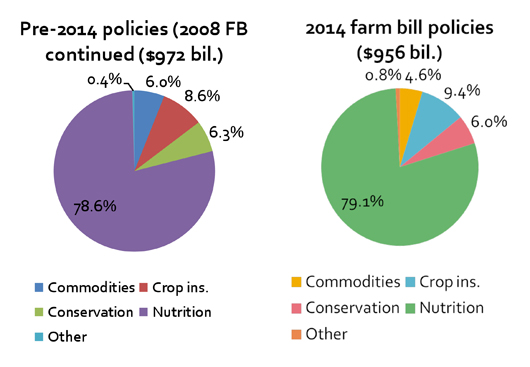California Agricultural Technology Institute
California dairy industry will see
program changes in new Farm Bill
Fresno State economist offers insights to regional banking firm
The 2014 Federal Farm Bill bumped and wound its way through congressional committees and floor votes for two and one-half years before finding itself on a ceremonial desk at Michigan State University earlier this year, awaiting the approving signature of President Barak Obama.
The $956 billion legislative action leaves California farm producers with a mix of gives and takes, according to an analysis provided by agricultural economist Dr. Mechel Paggi.
In a recent talk to the 4th Annual Robobank Industry Outlook Conference, Paggi, director of Fresno State’s Center
for Agricultural Business (CAB), discussed highlights of the bill, including several
provisions especially important to major sectors of the California agricultural economy.
“The new dairy program provisions along with the continuation and enhancement of programs in support of specialty crops are two areas that stand out,” Paggi said. “In addition, the elimination of direct payments to producers of traditional farm program crops like wheat and rice will also have an impact.”
The Agricultural Act of 2014 repeals some existing safety net programs for the dairy industry, including the dairy price support program, the milk income loss contract and the dairy export incentive program, Paggi noted. At the same time, crafters of the 2104 act added two new programs: the Margin Protection Program (MPP) for Dairy Producers, and the Dairy Product Donation Program (DPDP). The MPP will offer producers the opportunity to purchase insurance against milk income over feed costs falling below certain levels. The DPDP commits the USDA to purchase and distribute certain dairy products when price margins fall below a specified level for two consecutive months.
These changes could have broader economic impacts to the entire California agricultural economy – simply because of the breadth of the dairy industry in the Golden State, Paggi said. Milk and cream (more than 80 percent produced in the Central Valley – see graph below) led all other agricultural commodities with a gross sales value of nearly $7 billion in 2012, according to California Department of Food and Agriculture statistics. The closest commodity to milk and cream was grapes, with gross sales value of $4.4 billion in 2012.
 Rounding out the top five California ag commodities that year were shelled almonds,
with sales values of $4.3 billion; cattle and calves, worth $3.3 billion; and nursery
products, with sales values of $2.5 billion.
Rounding out the top five California ag commodities that year were shelled almonds,
with sales values of $4.3 billion; cattle and calves, worth $3.3 billion; and nursery
products, with sales values of $2.5 billion.
California specialty crop producers, who grow commodities ranging from almonds to zucchini, will receive additional support in the new Farm Bill, Paggi reported. The previous 2008 Farm Bill allotted $55 million in block grant funding for the support and promotion of specialty crops. The 2014 bill bumped that up to $72 million, with further increases anticipated in the future.
“These block grants will go to support projects in marketing, research, pest management and food safety, to name a few,” Paggi said. Competitive grant proposals for these funds will be peer reviewed for merit, relevance and impact by a USDA review and ranking committee comprised of specialty crop industry representatives.
The nearly 1,000-page 2014 Farm Bill contains an array of program provisions that will support agricultural production in California, Paggi said. But as is common in large pieces of legislation, the devil is in the details.
 “The exact operation of the bill depends on USDA interpretation of the legislative
language,” he said. Therefore, much administrative work remains to be done by California’s
agribusiness community to ensure that full realization of the bill’s provisions reaches
our producers, processors, exporters and their supporting business partners.
“The exact operation of the bill depends on USDA interpretation of the legislative
language,” he said. Therefore, much administrative work remains to be done by California’s
agribusiness community to ensure that full realization of the bill’s provisions reaches
our producers, processors, exporters and their supporting business partners.
Highlights of the farm bill will be a major topic of discussion at this year’s Agribusiness Management Conference, set for Nov. 5 in Fresno, Paggi said. Both legal and business specialists will be on hand to offer guidance for optimizing returns from the legislation.
For a complete PowerPoint presentation on Paggi’s farm bill analysis, or for more information about CAB economic research and presentations, visit the website at www.csufcab.com.